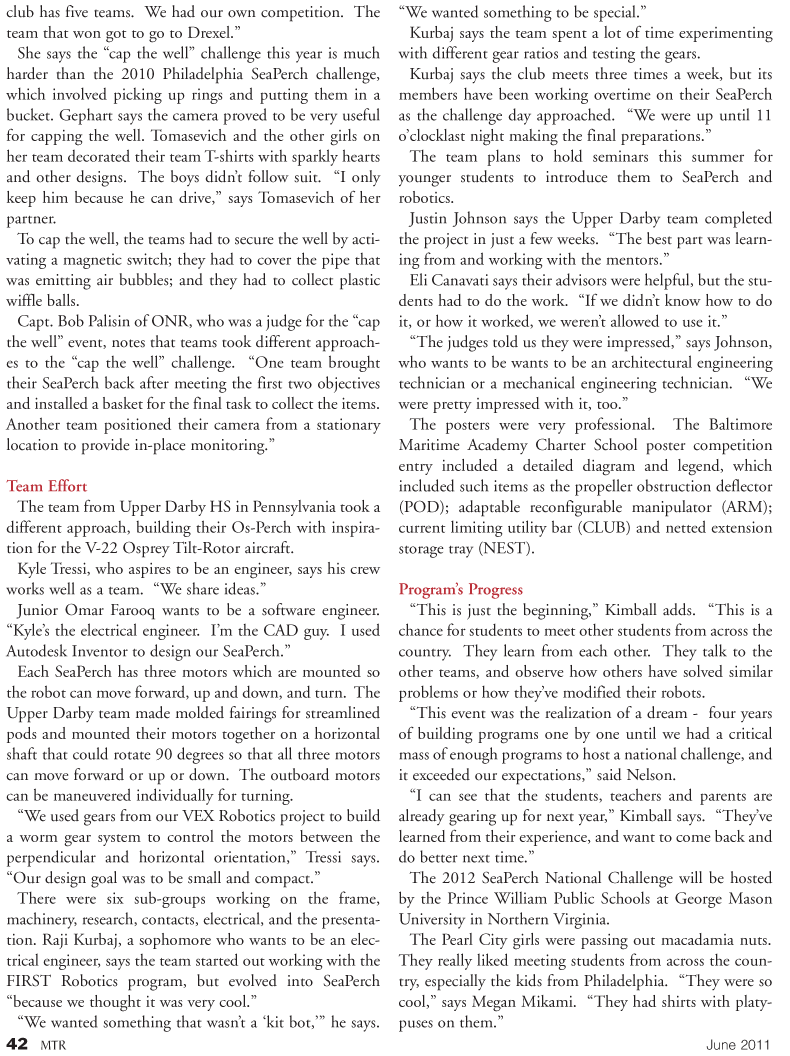
Page 42: of Marine Technology Magazine (June 2011)
Hydrographic Survey
Read this page in Pdf, Flash or Html5 edition of June 2011 Marine Technology Magazine
42 MTR June 2011 club has five teams. We had our own competition. The team that won got to go to Drexel.”
She says the “cap the well” challenge this year is much harder than the 2010 Philadelphia SeaPerch challenge, which involved picking up rings and putting them in a bucket. Gephart says the camera proved to be very useful for capping the well. Tomasevich and the other girls on her team decorated their team T-shirts with sparkly hearts and other designs. The boys didn’t follow suit. “I only keep him because he can drive,” says Tomasevich of her partner.
To cap the well, the teams had to secure the well by acti- vating a magnetic switch; they had to cover the pipe that was emitting air bubbles; and they had to collect plastic wiffle balls.
Capt. Bob Palisin of ONR, who was a judge for the “cap the well” event, notes that teams took different approach- es to the “cap the well” challenge. “One team brought their SeaPerch back after meeting the first two objectives and installed a basket for the final task to collect the items.
Another team positioned their camera from a stationary location to provide in-place monitoring.”
Team Effort
The team from Upper Darby HS in Pennsylvania took a different approach, building their Os-Perch with inspira- tion for the V-22 Osprey Tilt-Rotor aircraft.
Kyle Tressi, who aspires to be an engineer, says his crew works well as a team. “We share ideas.”
Junior Omar Farooq wants to be a software engineer. “Kyle’s the electrical engineer. I’m the CAD guy. I used
Autodesk Inventor to design our SeaPerch.”
Each SeaPerch has three motors which are mounted so the robot can move forward, up and down, and turn. The
Upper Darby team made molded fairings for streamlined pods and mounted their motors together on a horizontal shaft that could rotate 90 degrees so that all three motors can move forward or up or down. The outboard motors can be maneuvered individually for turning. “We used gears from our VEX Robotics project to build a worm gear system to control the motors between the perpendicular and horizontal orientation,” Tressi says. “Our design goal was to be small and compact.”
There were six sub-groups working on the frame, machinery, research, contacts, electrical, and the presenta- tion. Raji Kurbaj, a sophomore who wants to be an elec- trical engineer, says the team started out working with the
FIRST Robotics program, but evolved into SeaPerch “because we thought it was very cool.” “We wanted something that wasn’t a ‘kit bot,’” he says. “We wanted something to be special.”
Kurbaj says the team spent a lot of time experimenting with different gear ratios and testing the gears.
Kurbaj says the club meets three times a week, but its members have been working overtime on their SeaPerch as the challenge day approached. “We were up until 11 o’clocklast night making the final preparations.”
The team plans to hold seminars this summer for younger students to introduce them to SeaPerch and robotics.
Justin Johnson says the Upper Darby team completed the project in just a few weeks. “The best part was learn- ing from and working with the mentors.”
Eli Canavati says their advisors were helpful, but the stu- dents had to do the work. “If we didn’t know how to do it, or how it worked, we weren’t allowed to use it.” “The judges told us they were impressed,” says Johnson, who wants to be wants to be an architectural engineering technician or a mechanical engineering technician. “We were pretty impressed with it, too.”
The posters were very professional. The Baltimore
Maritime Academy Charter School poster competition entry included a detailed diagram and legend, which included such items as the propeller obstruction deflector (POD); adaptable reconfigurable manipulator (ARM); current limiting utility bar (CLUB) and netted extension storage tray (NEST).
Program’s Progress “This is just the beginning,” Kimball adds. “This is a chance for students to meet other students from across the country. They learn from each other. They talk to the other teams, and observe how others have solved similar problems or how they’ve modified their robots. “This event was the realization of a dream - four years of building programs one by one until we had a critical mass of enough programs to host a national challenge, and it exceeded our expectations,” said Nelson. “I can see that the students, teachers and parents are already gearing up for next year,” Kimball says. “They’ve learned from their experience, and want to come back and do better next time.”
The 2012 SeaPerch National Challenge will be hosted by the Prince William Public Schools at George Mason
University in Northern Virginia.
The Pearl City girls were passing out macadamia nuts.
They really liked meeting students from across the coun- try, especially the kids from Philadelphia. “They were so cool,” says Megan Mikami. “They had shirts with platy- puses on them.”

 41
41

 43
43
